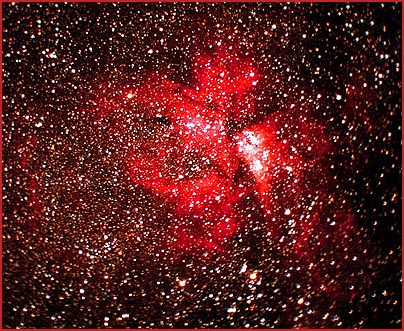NGC 3372 - Eta Carinae
 For an observer in the northern hemisphere, M-42 is a huge, naked eye object that is breathtaking, even in a small scope. If you look for its equal in the southern skies there is no doubt that the Eta Carinae region not only surpasses M-42, but takes your breath away!
For an observer in the northern hemisphere, M-42 is a huge, naked eye object that is breathtaking, even in a small scope. If you look for its equal in the southern skies there is no doubt that the Eta Carinae region not only surpasses M-42, but takes your breath away!
The Eta Carinae Nebula photographed from the 12,300 ft. observing site at SSSP97 with a 500mm f5.6 telescope/ 5 minutes on Fuji color negative film by Vic Winter.
Eta Carinae: RA 10hrs 44min. / Dec -59 degrees 52sec. (Carina) Distance: 9,000 ly
Type: emission
The Eta Carina Nebula is the largest diffuse nebula in the sky, much larger than the more famous Orion Nebula; that it is not better known is no doubt due to the fact that it is not visible from most of the Northern Hemisphere. The star Eta Carinae itself is also interesting. It is a variable star; in the mid-19th century it was the second brightest star in the sky; today it is not even visible with the naked eye. Such large stars are very unstable. Eta Carinae's most recent outburst in 1841 expelled the gas that creates the spectacular nebula (sometimes called the Homunculus Nebula) that we see today. The bright lobes of the nebula are about the same size as our whole solar system. Click on the thumbnail image for A NASA Hubble Space Telescope "natural color" image of the material surrounding the star Eta Carinae, as imaged by the Wide Field Planetary Camera 2 (WFPC-2).
Eta Carinae has a mass of approximately 150 times that of the sun, and is about 4 million times brighter than our local star, making it one of the most massive and most luminous stars known.
The ghostly red outer glow surrounding the star is composed of the very fastest moving of the material which was ejected during the last century's outburst. This material, much of which is moving more than two million miles per hour, is largely composed of nitrogen and other elements formed in the interior of the massive star, and subsequently ejected into interstellar space.
The bright blue-white nebulosity closer in to the star also consists of ejected stellar material. Unlike the outer nebulosity, this material is very dusty and reflects starlight. The new data show that this structure consists of two lobes of material, one of which (lower left) is moving toward us and the other of which (upper right) is moving away. The knots of ejected material have sizes comparable to that of our solar system.
Previous models of such bipolar flows predict a dense disk surrounding the star which funnels the ejected material out of the poles of the system. In Eta Carinae, however, high velocity material is spraying out in the same plane as the hypothetical disk, which is supposed to be channeling the flow.
The Keyhole Nebula is also located in this region... Take a look at David Malin's beautuful shot of this nebula.
More Eta Carina photographs (and southern skies star party photos) can be seen on NASA's Fred Espenak's page.
Back to ICSTARS.